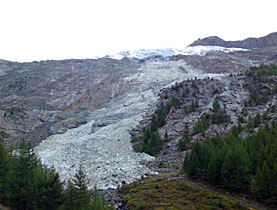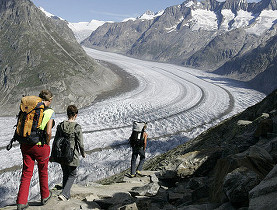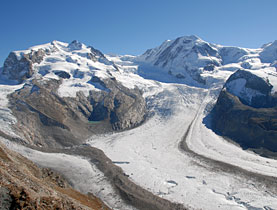Melting glaciers release toxins, warns study

Switzerland's steadily retreating glaciers are releasing hazardous man-made chemicals, according to new research.
Scientists have found persistent organic pollutants (POPs) like dioxins, PCBs and DDT in sediment at the bottom of the glacier-fed Lake Oberaar in central Switzerland. But question marks remain over the potential dangers for humans or the environment.
“This is the first study of its kind,” Peter Schmid, a chemist at the Swiss Federal Laboratories for Materials Testing and Research (EMPA), told swissinfo.ch. “The process of glaciers releasing POPs has been presumed for a while, but never proven.”
POPs are man-made organic compounds found in everything from paint to pesticides and remain in the environment for decades without breaking down.
While some hazardous chemicals, such as DDT and PCBs, are banned by the Stockholm Convention, others are still widely used, despite evidence that they may cause cancer or damage the body’s hormone system.
“These chemicals are very stable, don’t decompose in the environment and are transported over long distances,” Schmid explained.
Many of the compounds then attach themselves to particles that are deposited in the environment and can be found worldwide. They even exist in remote areas such as the Alps, the Arctic Circle or Antarctica, where they are condensed and stored in the ice.
“But due to the massive melting of glaciers over the past ten years, more melt water is being released, including these chemicals stored in the ice,” he said.
Swiss glaciers are retreating at an accelerating rate and the large majority could vanish this century, say glaciologists.
Slicing carrots
In winter 2006 researchers from EMPA, Zurich’s Federal Institute of Technology (ETH) and the Federal Institute for Environmental Science and Technology (Eawag) started analysing sediment cores from Lake Oberaar, situated at 2,300m close to the Grimsel Pass, for a wide range of POPs, pesticides and synthetic musk fragrances.
“Initial research dates back to 2003 when we detected high levels of toxins in fish in alpine lakes,” Schmid said. “We wondered why this was happening and then started analysing sediment in mountain lakes.”
The team extracted frozen “carrots” of ice and sediment, each one metre long and six centimetres in diameter.
“We then sliced up the carrots and freeze-dried them.”
The slices could be read like tree rings, strata by strata, from present day back to 1953, when the dam that formed Lake Oberaar was built.
New spike
“We were able to confirm using the layers that from 1960 to 1970 POPs were produced in large quantities and were deposited in this alpine lake,” said ETH environmental scientist Christian Bogdal.
Bogdal was able to clearly identify increases in levels of POPs in the 1950s, which peaked in the 1960s-1970s, and decreased again to low levels in the 1980s-1990s.
This reflected the emission history of these compounds and technical improvements and regulations leading to reduced emissions some decades ago.
But since the late 1990s all compound classes found in Lake Oberaar have increased sharply and some toxins are of a similar level to or even higher than those in the 1960s-1970s. Their findings were replicated at two other glacial lakes in the Swiss Alps.
This second peak supports the hypothesis that there is a “relevant” release of persistent organic chemicals from melting alpine glaciers, the scientists claim.
Since 1930 the Oberaar Glacier, which feeds into the lake, has reduced in length by 1.6km and by 120m over the past decade alone.
Dangerous?
This issue needs to be taken very seriously, the scientists warn.
“Considering ongoing global warming and accelerated massive glacier melting predicted for the future, our study indicates the potential for dire environmental impacts due to pollutants delivered into pristine mountainous areas,” they wrote.
“I think we should be worried as we can’t foresee how high these releases will be,” Schmid said. “We don’t know if it’s the start of a massive release or the peak of the current release.”
So just how dangerous are these chemicals?
“Fortunately these compounds are absorbed by particles and deposited in aquatic systems, so there’s no direct danger for drinking water. But local ecosystems could be endangered by compounds in higher concentrations,” he said.
“It could be a danger for humans; it cannot be excluded.”
The chemists, geologists and glaciologists intend to pursue their investigations, examining the quantities of chemicals locked in glaciers and the way they are released. They will also look into whether compounds decompose or are transformed by ultra-violet light.
Simon Bradley, swissinfo.ch
Glaciers are large masses of snow, ice and rock debris that accumulate in great quantities and begin to flow outwards and downwards under the pressure of their own weight.
They are formed when yearly snowfall in a region far exceeds the amount of snow and ice that melts in a given summer.
In Switzerland, glaciers play an important role as water reservoirs for hydro-power production (generating 50% of the country’s electricity). They are also considered an important tourist attraction.
Glaciers around the globe have been shrinking significantly since the second half of the 19th century, according to the Swiss-based World Glacier Monitoring Service.
Under current climate scenarios presented by the Intergovernmental Panel on Climate Change (IPCC), the ongoing trend of worldwide and rapid, if not accelerating, glacier shrinkage may lead to the deglaciation of large parts of many mountain ranges by the end of the 21st century.
According to research by Zurich’s Federal Institute of Technology some ten cubic kilometres of ice was lost from 1,500 glaciers over a nine-year period from 1999-2008 – or 13 per cent.
The Stockholm Convention, that entered into force on May 17, 2004, aims to introduce a worldwide ban on the production and use of Persistent Organic Pollutants (POPs), which are harmful chemicals in the environment that build up through the food chain.
The 12 chemical products that are subject to the Stockholm Convention: aldrin, chlordane, DDT, dieldrin, endrin, heptachlor, mirex, hexachlorobenzene and toxaphene (pesticides), dioxins and furans (industrial by-products), PCBs (industrial chemicals).
Leading candidates to be added to the list are: pentabromodiphenyl ether, chlordecone, hexabromobiphenyl, lindane and perfluorooctane sulfonate.

In compliance with the JTI standards
More: SWI swissinfo.ch certified by the Journalism Trust Initiative














You can find an overview of ongoing debates with our journalists here . Please join us!
If you want to start a conversation about a topic raised in this article or want to report factual errors, email us at english@swissinfo.ch.